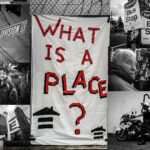Alongside Nolensville Pike—a congested, auto-oriented, typical arterial highway in South Nashville—lives a thriving community of immigrants and refugees primarily composed of Latinx, Kurdish, Somali and Sudanese populations. In the past decade, trusted community organization Conexión Américas has worked in partnership with community members, government agencies, and artists to make a number of safety improvements to Nolensville Pike.
The challenge
In South Nashville, along the wide urban highway of Nolensville Pike, lives a thriving community of immigrants and refugees primarily composed of Latinx, Kurdish, Somali and Sudanese populations. However, for most of its history, Nolensville Pike has been a congested, auto-oriented, typical arterial highway with eroded or non-existent sidewalks, few crosswalks, insufficient bicycle and pedestrian infrastructure, and no bus shelters, where travel outside of a car is unpleasant and often dangerous.

Photo: Rochelle Carpenter 
Photo: Rochelle Carpenter 
Photo: Rochelle Carpenter
The project
In the past decade, trusted community organization Conexión Américas has worked in partnership with community members, the Nashville Area Metropolitan Planning Organization (MPO)—which has been a leader in demonstrating how an MPO can help build healthier communities—the Nashville Metropolitan Transit Authority, and artists to make a number of improvements to Nolensville Pike, including:
- The city’s first bilingual crosswalk. In 2014, Conexión Américas’ partnered with the Nashville Area MPO, Metro Department of Public Works, and Tennessee Department of Transportation to develop and install the city’s first bilingual crosswalk (with instructions in both English and Spanish) on Nolensville Pike. Designed to reflect the neighborhood’s diversity and cultural assets, this crosswalk connects the community center Casa Azafrán with the local bus stop and parking spots for staff and visitors; solidifies the corridor as a home for the Latino community; and inspired residents, local businesses and community groups to think of their own transportation improvement ideas.
- Conexión Américas multimodal examination of Nolensville Pike. In 2016, Conexión Américas conducted a series of projects to better understand transportation needs along Nolensville Pike. These three projects are detailed in Envision Nolensville Pike, a plan for the arts-driven plan calling for the equitable redevelopment of the corridor’s transportation infrastructure.
- Nolensville Pike bus shelter project where high school students designed and built a temporary bus shelter to test out ideas and start a conversation about improving transportation infrastructure,
- ‘Estamos Aqui’: transportation oral history project where high school students interviewed longtime residents about their memories and experiences with transportation and produced an oral history project of their learnings.
- Creative Labs, a month-long series facilitated by a storyteller, in which community members discussed in culturally-specific settings the assets and shortcomings of the Nolensville Pike corridor.
- Student interns’ projects to improve public space. In the Summer of 2018, 12 high school students and 1 elementary student participated in a “Design your neighborhood” internship program. In this program, students learned the basics of city and transportation planning, conducted community research, and designed and built five projects to improve public space along Nolensville Pike. These projects included new crosswalks that feature symbols that are important to people who live and work in the area. For example, the crosswalk leading to the mosque features geometric Islamic art.
- Pedestrian safety demonstration projects. Staff from The Salahadeen Center and Conexión Américas, who lead the Envision Nolensville Pike Collaborative, have held community conversations and events that have produced a vision for pedestrian improvements since 2015. Those efforts laid the groundwork for a temporary pedestrian path to be implemented in the summer of 2019. The path was well received by business owners, transit riders, and the community at large.
The results
Along with its partners, Conexión Américas leadership and deep connections to the community have helped to create a community-led vision for transportation investments in the corridor, identified unique concerns about and ideas for transportation in their neighborhoods, and energized community members to participate in planning processes. Lessons learned included:
- Having dedicated staff from government agencies to help navigate regulations and decision-making processes can help the community realize their visions.
- Using an arts-based focal point can build momentum and support for public works projects.
- Engaging effective local messengers to voice the vision, explain the need, and make the ask can make a world of difference when budgets are tight, backlogs exist and transportation projects compete.
Key partners: Conexión Américas, Salahadeen Center, Nashville Metro Arts, Greater Nashville Regional Council, Nashville Civic Design Center, Metropolitan Government of Nashville and Davidson County.













